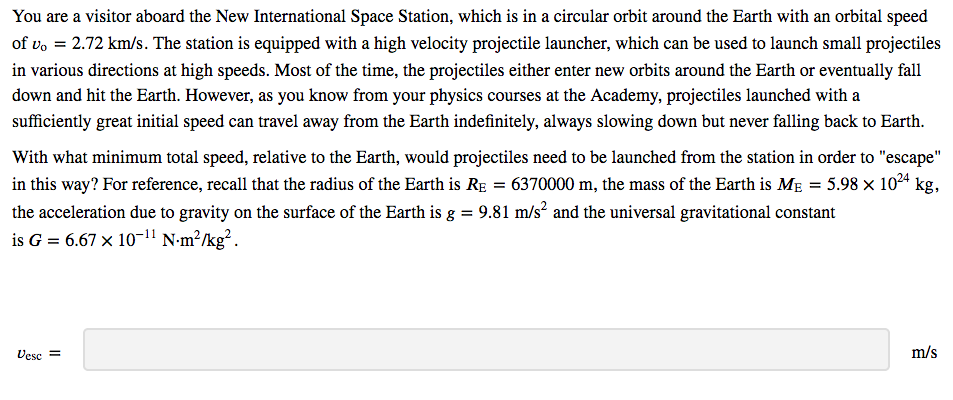You are a visitor aboard the New International Space Station, which is in a circular orbit around the Earth with an orbital speed of vo = 2.72 km/s. The station is equipped with a high velocity projectile launcher, which can be used to launch small projectiles in various directions at high speeds. Most of the time, the projectiles either enter new orbits around the Earth or eventually fall down and hit the Earth. However, as you know from your physics courses at the Academy, projectiles launched with a sufficiently great initial speed can travel away from the Earth indefinitely, always slowing down but never falling back to Earth. With what minimum total speed, relative to the Earth, would projectiles need to be launched from the station in order to "escape" in this way? For reference, recall that the radius of the Earth is Rg = 6370000 m, the mass of the Earth is MẸ = 5.98 × 10²ª kg, the acceleration due to gravity on the surface of the Earth is g = 9.81 m/s² and the universal gravitational constant is G = 6.67 × 10-1! N-m²/kg².
You are a visitor aboard the New International Space Station, which is in a circular orbit around the Earth with an orbital speed of vo = 2.72 km/s. The station is equipped with a high velocity projectile launcher, which can be used to launch small projectiles in various directions at high speeds. Most of the time, the projectiles either enter new orbits around the Earth or eventually fall down and hit the Earth. However, as you know from your physics courses at the Academy, projectiles launched with a sufficiently great initial speed can travel away from the Earth indefinitely, always slowing down but never falling back to Earth. With what minimum total speed, relative to the Earth, would projectiles need to be launched from the station in order to "escape" in this way? For reference, recall that the radius of the Earth is Rg = 6370000 m, the mass of the Earth is MẸ = 5.98 × 10²ª kg, the acceleration due to gravity on the surface of the Earth is g = 9.81 m/s² and the universal gravitational constant is G = 6.67 × 10-1! N-m²/kg².
Physics for Scientists and Engineers: Foundations and Connections
1st Edition
ISBN:9781133939146
Author:Katz, Debora M.
Publisher:Katz, Debora M.
Chapter7: Gravity
Section: Chapter Questions
Problem 7PQ: Model the Moons orbit around the Earth as an ellipse with the Earth at one focus. The Moons farthest...
Related questions
Question

Transcribed Image Text:You are a visitor aboard the New International Space Station, which is in a circular orbit around the Earth with an orbital speed
of vo = 2.72 km/s. The station is equipped with a high velocity projectile launcher, which can be used to launch small projectiles
in various directions at high speeds. Most of the time, the projectiles either enter new orbits around the Earth or eventually fall
down and hit the Earth. However, as you know from your physics courses at the Academy, projectiles launched with a
sufficiently great initial speed can travel away from the Earth indefinitely, always slowing down but never falling back to Earth.
With what minimum total speed, relative to the Earth, would projectiles need to be launched from the station in order to "escape"
in this way? For reference, recall that the radius of the Earth is RE = 6370000 m, the mass of the Earth is MẸ = 5.98 × 1024 kg,
the acceleration due to gravity on the surface of the Earth is g = 9.81 m/s and the universal gravitational constant
is G = 6.67 x 10-1! N-m²/kg².
Vesc =
m/s
Expert Solution
This question has been solved!
Explore an expertly crafted, step-by-step solution for a thorough understanding of key concepts.
This is a popular solution!
Trending now
This is a popular solution!
Step by step
Solved in 2 steps

Knowledge Booster
Learn more about
Need a deep-dive on the concept behind this application? Look no further. Learn more about this topic, physics and related others by exploring similar questions and additional content below.Recommended textbooks for you

Physics for Scientists and Engineers: Foundations…
Physics
ISBN:
9781133939146
Author:
Katz, Debora M.
Publisher:
Cengage Learning

Principles of Physics: A Calculus-Based Text
Physics
ISBN:
9781133104261
Author:
Raymond A. Serway, John W. Jewett
Publisher:
Cengage Learning

Physics for Scientists and Engineers: Foundations…
Physics
ISBN:
9781133939146
Author:
Katz, Debora M.
Publisher:
Cengage Learning

Principles of Physics: A Calculus-Based Text
Physics
ISBN:
9781133104261
Author:
Raymond A. Serway, John W. Jewett
Publisher:
Cengage Learning